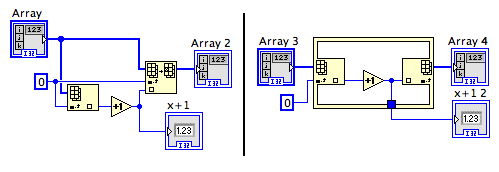Leaderboard
Popular Content
Showing content with the highest reputation on 11/06/2011 in all areas
-
No offense taken, Daklu. The technical feedback is generally valuable. In this case, I suggest your statement is sometimes true, but not always, and I'm not sure whether it is true in this case, so I'm going to walk through my thought process publicly. Let's start with this example. The code on either side of the black bar does the same functionality: Suppose many users are writing the code on the left, which is less efficient than the code on the right. Is that a deficiency of the language? No. Is it a deficiency of our documentation? I'm not sure... it certainly doesn't seem like it is LabVIEW's job to be documenting all the possible trig identities. Maybe VI Analyzer could detect simple trig substitutions like this one, but it would be hard to teach it all the known interesting identities. So if I saw many customers writing the code on the left and posted "hey, you should use the code on the right", that wouldn't reflect a deficiency in the language. I believe that the above demonstrates that that the assertion of "efficiency advisory implies language deficiency" is not universally true. Next thought experiment: Advising users to use the Inplace Element Structure instead of Index Array and Replace Array Subset. The structure node gives LabVIEW information about your intentions that is hard or impossible (depending upon the exact code you write) to derive otherwise, and the compiler can use that information to make more efficient code. This is an example of, essentially, using exactly the same two nodes, but using them in a specific way. Is the language deficient? No, it provides a way to make your intentions clear to the compiler. Is the compiler deficient? Yes. In much the same way as the trig identity substitution, the compiler is not smart enough to recognize what you're doing. So it is a lack of artificial intelligence. But it does demonstrate that an efficiency advisory to use a node (or pair of nodes) in a particular way is not necessarily a language deficiency. That brings us to the current case of the To More Specific node. Does it add anything to the language to have a different node that does the type testing? Functionally it would be absolutely the same as the existing To More Specific node, but missing the "object out" terminal. Let's call it the "Is More Specific" node... and I'll refer to them as "Is" and "To" for short. If we have "To", there's no need, functionally, for "Is", as long as people know how to use it. In other words, adding the "Is" node would still leave us with the same problem of teaching people when to use "Is" vs. when to use "To". On the flip side, if we had "Is" in the palettes, it might make people ask the question, "Why do I need this other node when I already have this first node?" That's the effect today with the Inplace Element Structure -- just have the IPE struct makes people question, "When would I ever use this if I have the direct nodes?" So although the "Is" would be noise from a "does it do anything new" perspective, that extra static might make people question, thus aiding with the education problem. On the other hand, if people could always use the IPE, I suspect we would remove the individual nodes from the palettes and send everyone to the IPE always. But there are times when you only want one half of the pair, so the individual nodes stay. In this case, we have a situation where the "To" node would *always* suffice for the "Is" node. Overall, we are talking about avoiding one object copy. Yes, that might be critical in some domains, I grant, but this is hardly the most exotic tool in the "hide the dots" toolbox. Is it really worth the extra node? I don't know. I'm inclined to say "no", but I suspect some part of me is saying that just because I'd have to take on the work of actually creating that node, which would be a relatively boring task to undertake compared to other things I could be working on, so in this instance, my objectivity is compromised (providing new functionality is almost always more interesting than rehashing existing functionality... I'm sure most of you, as programmers, have experienced that... unless it is someone else's code originally that totally sucks and you get to have great fun ripping out the ugliness). So, that's my arguments for/against the "Is" node.1 point



